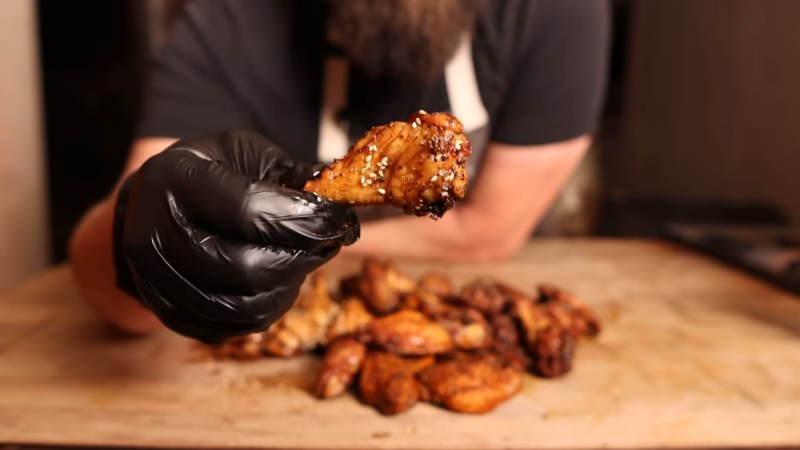Assessing the healthiness of smoked chicken wings is complex and depends on their nutrition and preparation. Chicken wings are protein-rich but can be fatty, especially with the skin.
Smoking adds flavor but doesn’t alter their basic nutrition compared to frying or baking. For a balanced diet, it’s key to consider their macronutrients and overall dietary pattern.
Consuming wings in moderation, with minimal added fats and salts, can fit into a healthy diet. Using spice rubs instead of sugary sauces and choosing high-quality chicken can enhance nutrition.
Pairing wings with vegetables and whole grains can also balance the meal.
Health Implications
Smoked wings are often healthier than fried wings due to their lower fat and calorie content. Yet, their nutritional value depends on how they’re prepared and any added sauces or toppings.
It’s important to assess the sodium content of smoked wings and their effect on heart health, understand their contributions to muscle and bone health, be aware of any risks, and consider choosing options with fewer calories and less fat for a balanced diet.
Analyzing Sodium and Heart Health
Smoked wings typically have a higher sodium content compared to unprocessed chicken due to the salts used in the smoking process. High sodium intake is linked to hypertension, which is a risk factor for heart disease and stroke.
Managing intake is especially crucial for individuals with existing cardiovascular conditions.
Potential Benefits for Muscle and Bone Health
Despite concerns related to sodium, smoked wings are a good source of protein, supplying essential amino acids necessary for muscle repair and growth. They also contribute to bone health, thanks to their content of calcium and collagen, albeit to a lesser extent than other foods specifically rich in these nutrients.
Possible Risks and Injuries
Excessive consumption of smoked meats, including wings, can be linked to health risks. For instance, persistent high sodium can potentially lead to atherosclerosis, and some studies suggest that purine-rich foods might exacerbate conditions like gout.
Care should be taken to avoid these risks by consuming in moderation.
Low-calorie and Low-Fat Alternatives
Compared to their fried counterparts, smoked wings are often viewed as a healthier alternative because they are low in calories and have less fat content. Opting for low-sodium preparations can further reduce health disadvantages.
Substitutions such as incorporating herbs can offer flavor without high sodium levels.
Techniques for Healthier Preparation
Creating healthier smoked chicken wings hinges on thoughtful preparation, cooking methods, and serving choices. Each step, from the marinade to how they are cooked and served, can significantly influence both the flavor and nutritional content.
Preparation: Rubs and Marinades
One can infuse chicken wings with flavor without adding excessive calories by using a rub made of spices like smoked paprika, garlic powder, onion powder, and cayenne. These ingredients not only impart a rich taste but are also free from the added sugars often found in bottled marinades.
For a rub that balances flavor and health, mix:
- 1 tbsp of kosher salt
- 2 tbsp of smoked paprika
- 1 tbsp of onion powder
- 1 tbsp of garlic powder
- 1 tsp of cayenne
Rubbing the wings with a touch of olive oil before applying the dry spice blend helps the spices adhere better and promotes an even cooking surface.
Cooking Methods: Smoking vs Baking vs Frying
When considering cooking methods, smoking the wings on a grill or smoker at the ideal internal temperature of 165°F ensures they are both safe to eat and remain juicy. Smoking imparts a distinct flavor and allows the fat to render slowly, producing a satisfying texture.
For those without a smoker, baking the wings in an oven or air fryer can produce a similar texture while using less fat than frying. Here are options for cooking methods:
- Smoker/Grill: Infuses smoky flavor; cook until the internal temperature reaches 165°F.
- Oven Baking: A healthy alternative that can still yield crispy skin.
- Air Fryer: Offers a texture akin to frying but with significantly less oil.
Serving Suggestions: Accompaniments and Portions
The accompaniments served with smoked chicken wings can also have an impact on their overall healthfulness. Instead of traditional sides like fries, offer grilled corn or a side salad to add nutrients without too many extra calories.
For dips, opt for Greek yogurt-based sauces or a homemade BBQ sauce where one can control the amount of salt and sugar. It’s also important to consider portion sizes; serving 4-6 wings per person can help control calorie intake.
When refrigerating leftovers, ensure to store them in a sealed container in the fridge to maintain freshness and prevent contamination. By following these techniques, one can enjoy smoked chicken wings that are both delicious and healthier.
Substitutes and Healthier Alternatives
In pursuit of healthier eating habits, individuals often seek substitutes for traditional smoked wings. The focus remains on reducing health risks associated with high-fat content while still enjoying flavorful options.
Choosing Ingredients for Reduced Health Risks
Grilled chicken wings are frequently recommended as a healthier alternative to smoked wings due to their reduced fat content. Selecting skinless wings can significantly lower the fats associated with poultry.
When marinades are called for, opting for heart-healthy olive oil mixed with herbs can provide flavor without excess calories. Using spices and herbs not only boosts taste but also cuts down on the need for additional sauces which often contain high levels of sugar and sodium.
- Ingredients for Healthier Wings:
- Skinless chicken wings to reduce fats
- Olive oil or other low-fat marinades
- A variety of herbs and spices for flavoring
Non-Traditional Cooking Methods
Cooking methods such as using an air fryer can replicate the texture of fried or smoked wings with far less oil, reducing both fat content and calories. It circulates hot air around the wings at a high temperature, creating a crispy outer layer.
Utilizing a thermometer can ensure that chicken is cooked safely to the appropriate internal temperature without overcooking, which can help retain natural juices. Grilled chicken wings, especially when cooked on an open flame, imbue a smoky flavor while also diminishing fat as it drips away from the meat.
- Non-Traditional Cooking Methods:
- Air fryer for lower fat content
- Grilled wings for a smoky flavor with less fat
- Use of a thermometer to ensure proper cooking temperatures
The Broader Context in a Healthy Diet
When considering the role of smoked chicken wings in a diet, it’s essential to analyze how they can be part of balanced meals, the importance of portion control, and how they compare nutritionally to other chicken products.
Incorporating Smoked Wings into Balanced Meals
Smoked chicken wings can be a flavorful addition to a balanced diet when paired with the right accompaniments. Each wing is packed with protein, which is vital for muscle repair and growth.
To round out the meal, it’s beneficial to include foods high in fiber, vitamins, and minerals. For instance, serving smoked wings with a side of leafy greens or a quinoa salad can enhance the nutritional value of the course.
- Example Meal:
- Smoked Wings: 6 pieces
- Side Salad: Including tomatoes, spinach, and carrots
- Whole Grain: 1 serving of brown rice or quinoa
- Dressing: Olive oil-based vinaigrette
Portion Control
Portion control is key when incorporating smoked wings into one’s diet. While chicken wings are high in protein, they can also be laden with calories and fat, especially if the skin is left on. It’s advisable to consume them in moderation, being mindful of the serving size.
- Recommended Serving:
- Men: 3–4 wings
- Women: 2–3 wings
- Children: 1–2 wings
This moderation helps to prevent excessive caloric intake which can lead to weight gain.
Comparison with Other Chicken Products
Smoked wings are just one way to enjoy chicken; other methods of preparation could offer different health advantages. For instance, grilled chicken wings may have a lower fat content compared to their smoked counterparts if they’re grilled without additional oil or butter.
Baked chicken wings can also be a healthier option as baking can reduce the sodium content typically found in cured or smoked meats. However, BBQ chicken wings might come with added sugars and calories due to sauce applications.
- Nutrient Comparison (per 100g serving):
- Smoked Wings: Protein – 20g, Fat – 12g
- Grilled Wings: Protein – 22g, Fat – 10g
- Baked Wings: Protein – 24g, Fat – 8g
- BBQ Wings: Protein – 20g, Fat – 12g, Sugars – 2g
A key takeaway is that while smoked wings have a place in a balanced diet, they ought to be enjoyed within the scope of overall dietary choices that prioritize health and nutrition.
FAQ
Are smoked chicken wings better for weight loss than fried wings?
Smoked chicken wings can be a better option for weight loss compared to fried wings due to their typically lower fat and calorie content. However, portion control and overall dietary choices are crucial for effective weight management.
Can smoked chicken wings be part of a heart-healthy diet?
Smoked chicken wings can be part of a heart-healthy diet if they are prepared with reduced sodium and served in moderation. Choosing wings smoked without added salts and pairing them with heart-healthy sides can help.
How does the protein content in smoked chicken wings benefit the body?
The protein in smoked chicken wings aids in muscle repair and growth. It’s a crucial nutrient for muscle health, making these wings a beneficial part of a diet focused on physical fitness and muscle building.
What are healthier alternatives to traditional smoked chicken wing sauces?
Healthier alternatives to traditional sauces include homemade sauces with lower sugar and salt content, or spice rubs made from a blend of herbs and spices that provide flavor without added calories or sodium.
Are there any risks associated with consuming smoked chicken wings regularly?
Regular consumption of smoked chicken wings, especially with high sodium content, can increase the risk of hypertension and heart-related issues. Moderation and careful preparation can mitigate these risks.
How can smoked chicken wings be made more nutritious?
To make smoked chicken wings more nutritious, remove the skin to reduce fat content, use a healthy spice rub instead of sugary sauces, and pair them with fiber-rich vegetables and whole grains to balance the meal.
Bottom Line
In summary, smoked chicken wings can be a healthy option when consumed in moderation and prepared thoughtfully. They are high in protein but can be fatty, especially with skin.
The smoking process adds flavor without altering their basic nutrition. Choosing healthier preparation methods, like using spice rubs instead of sugary sauces and selecting quality chicken, can enhance their nutritional value.
Pairing them with vegetables and whole grains helps create a balanced meal. However, it’s important to consider their sodium content for heart health and to be aware of potential health risks.
Opting for lower-calorie, lower-fat alternatives can further contribute to a healthier diet.






















